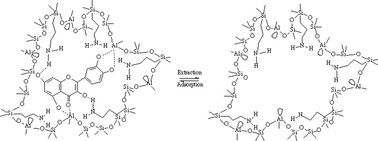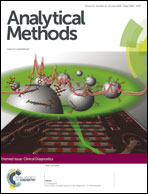Synthesis and characterization of molecularly imprinted silica mediated by Al for solid phase extraction of quercetin in Ginkgo biloba L.
Abstract
A bi-functionalized molecularly imprinted silica (MIS) was prepared for solid phase extraction of quercetin. To ensure the specificity of molecular recognition, aluminum ions were inserted in the silica matrix to form Lewis and Brønsted acid sites and allow the interaction with quercetin, as well as with 3-aminopropyltriethoxysilane as a functional monomer. A sol–gel process was used to prepare MIS–Al with tetraethoxysilane as the crosslinker reagent. The efficiency of imprinted silica was evaluated by comparing the amount of quercetin adsorbed by MIS–Al with those by non-imprinted silica (NIS–Al) and control polymers without Al. The adsorption capacity and extraction efficiency were studied using different solvents and a mixture of ethanol–water (60 : 40, v/v) was found to be most effective for the binding of quercetin with MIS–Al while pure ethanol was most effective for extraction. The selectivity was evaluated by HPLC using a mixture of quercetin and rutin, a molecule which was considered to have an analogous structure. Characterization of the imprinted silica and adsorption capacity tests suggested that the MIS–Al had a higher adsorption capacity and reproducibility than MIS without Al (248.5 ± 3.5 against 159.7 ± 35.0), proving that the presence of aluminum ions improved the selectivity and efficiency for quercetin extraction. Herbal medicine samples of Ginkgo biloba L. capsules (40 and 80 mg) were analysed by passing the extract through an SPE–MIS–Al cartridge and the fractions collected were analysed by HPLC-PDA. The MIS–Al was shown to be selective and resulted in cleaner chromatograms with better resolution of the quercetin peak, proving this to be an effective clean-up step before chromatographic analysis. By the proposed method, it was found that 40 and 80 mg capsules contained 0.25 ± 0.01 mg and 0.24 ± 0.01 mg quercetin per capsule of Ginkgo biloba L., corresponding to 2.6% and 1.3% (w/w), respectively. These results are in agreement with scientific studies in the literature that reports a range of 0.5 to 4.7% mg of quercetin per capsule.

- This article is part of the themed collection: Analytical Sciences in Brazil

 Please wait while we load your content...
Please wait while we load your content...